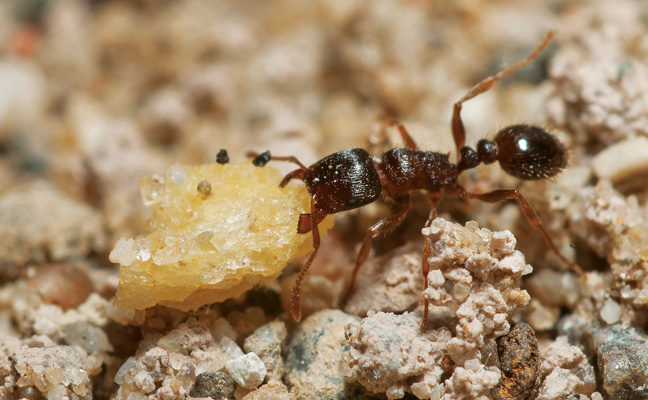
A pavement ant worker takes food back to share with its colony. Photo: courtesy of, and copyrighted by, Gene White, pmimages@earthlink.net
Tetramorium immigrans (previously T. caespitum)
Alias: Pavement ant
Description
- This species is a small, 1/8- to 1/6-inch long, dark brown ant with paler legs and antennae.
- On the head and thorax are visible parallel lines, or ridges, that are the same color as the cuticle; they give the cuticle a grooved texture.
- A pair of small spines are at the back of the thorax.
- The body has a sparse array of small hairs all over it.
- The pavement ant’s stinger is used more for applying trailing pheromone and less for defensive purposes.
- Queens are larger, at 1/4- to 1/3-inch, and are dark brown. They also have a sculpted head and thorax.
Life Cycle
- Pavement ants form large colonies that often contain 3,000 to more than 10,000 workers.
- They have distinct castes, with one or a few reproductive queens, and numerous non-reproductive female workers.
- Winged reproductive females and males are produced in early summer.
- Most colonies are monogynous — they are started by a single reproductive queen that carries out all reproduction for the lifetime of that colony — but they occasionally may have two, or possibly more, queens.
Behavior
- They prefer to nest in areas with minimal vegetation, such as an urban habitat.
- Nests usually are located outdoors under stones, garden pavers, and pavement (asphalt and concrete). Nests also can be located under porches and foundation slabs. They occasionally are found in exterior walls, under flooring, and in insulation.
- In homes with slab-on-grade construction, foragers enter through cracks in the slab, expansion joints and utility penetrations.
- Large-scale fights between non-related pavement ant colonies are common in the spring and beginning of summer, when the ants are developing their territories.
- They move slowly and enter buildings in search of food.
Food
- Pavement ants prefer greasy and sweet materials, which means they will respond at different times to either sugar- or protein-based baits.
- Workers use pheromones to recruit fellow workers to a food source, making it possible for large groups of workers to take unwieldy food back to the colony.
Range
➔ Pavement ants are common throughout most of the United States, in the Midwest and in the Pacific Northwest, but they are an occasional pest in southern states.
➔ Its native range in Europe is wide; at the beginning of the 19th century, it was introduced into the United States.
Prevention
➔ Seal entry points into structures, and remove food sources by keeping food sealed.
SOURCES:
Truman’s Scientific Guide to Pest Management Operations
University of Florida, Institute of Food and Agricultural Sciences Extension
Leave A Comment